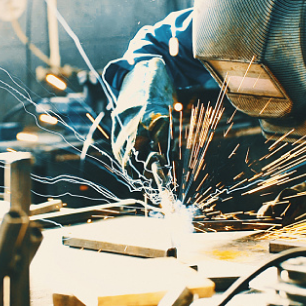Jump to:
Welding of Seismic Connections Is a Team Effort
AWS D1.8/D1.8M:2025, Structural Welding Code — Seismic Supplement, addresses welded joints designed in conformance with ANSI/AISC 341, Seismic Provisions for Structural Steel Buildings. The AISC 341 standard addresses specific requirements for design, fabrication, quality control, and quality assurance for the members and connections that handle seismic loading. As such, AISC 341 is a supplement to ANSI/AISC 360, Specification for Structural Steel Buildings. In a similar manner, AWS D1.8 is the supplement to AWS D1.1/D1.1M, Structural Welding Code — Steel.
Historical Context
The 1994 Northridge earthquake, along with extensive research conducted by the Federal Emergency Management Agency/SAC Joint Venture (FEMA/SAC) program following the earthquake, demonstrated that to achieve adequate performance of welded steel structures under severe earthquake-induced inelastic straining conditions, additional controls on design, detailing, materials, workmanship, testing, and inspection were necessary. FEMA-353, Recommended Specifications and Quality Assurance Guidelines for Steel Moment-Frame Construction for Seismic Applications, was published in 2000 and covered a broad range of topics but was not a standard.
To address welding, the first edition of AWS D1.8 was published in 2005, providing numerous details and requirements specific to field-welded reduced beam section beam-to-column moment connections that, due to a large number of successful connection tests, dominated the steel building market at that time. AWS D1.8 included general welding requirements for all welded seismic connections, including filler metal notch toughness, qualification testing for personnel welding beam-to-column moment connections, weld access holes details, backing use and removal, weld tab use and removal, protected zones that limited welding and repair methods, nondestructive examination (NDE) technician skills, and NDE requirements using both ultrasonic testing and magnetic particle testing for certain applications.
Code Relationships
AISC 341 includes welding requirements and references AWS D1.8 in several areas. While many provisions are similar to those in AWS D1.8, some are incorporated without direct reference to AWS D1.8. AISC 341 relies upon AWS D1.8 for welding consumables for both seismic force-resisting system welds and demand critical welds. AWS D1.8 is also cited for column splices, weld access holes for certain systems, doubler plate welding, weld tab welding, continuity plate welding, inspection, and NDE. AISC 341 addresses numerous seismic-force-resisting systems, including a variety of moment frames, braced frames, and shear wall systems. Many systems contain a Section 6, Connections, that often includes specific welding requirements, including identifying demand critical welds.
In addition to AISC 341, an additional AISC seismic standard was developed: ANSI/AISC 358, Prequalified Connections for Special and Intermediate Steel Moment Frames for Seismic Applications. The number of seismic moment connections used in steel buildings has continued to grow with each new edition of AISC 358, and the specific welding requirements, including connection details, weld details, and protected zones, have been included within AISC 358. In addition to Chapter 3, “Welding Requirements,” which draws from AWS D1.8, the current AISC 358 contains several welded prequalified moment connections: reduced beam section, end plate, bolted flange plate, welded unreinforced, cast bolted bracket, ConXtech® ConXLTM, MiTek SidePlate®, Simpson Strong-Tie® Strong Frame®, and DuraFuse Frames. Each of these moment connections includes specific welding details for that system.
Key Changes in the 2025 AWS D1. 8 Edition
So, why has this article not yet described the changes to AWS D1.8 for 2025? Welding professionals must recognize that AWS D1.8 is not the only standard to follow. AISC 341 and AISC 358 are essential, as are the overarching standards AWS D1.1 and AISC 360.
The 2025 edition of AWS D1.8 Clause 1.4.1, addressing engineers’ responsibilities, was modified to align more directly with the requirements of AISC 341, not only in the order of the list but in the descriptions of the items. It should be noted that the list is in addition to the list in AWS D1.1.
Over the years, there has been occasional confusion about the use of prequalified welding procedures, with some applying limitations incorrectly, others not understanding the filler metal testing criteria in Annex A and how those test reports are applied to prequalified welding procedure specifications (WPSs). Some falsely believed prequalified WPSs could not be used in demand critical joints. The 2025 edition has undergone a substantial update, incorporating specific language throughout the code and commentary to clarify the testing of filler metals evaluated using Annex A, the use of these tested filler metals, and their use in prequalified joint details.
As an example, one can use prequalified WPSs for demand critical welds. Annex A testing can be used to verify mechanical properties and to establish heat input bounds for the prequalified WPS. If the WPS falls outside the boundaries of the Annex A testing, then it must be qualified. Some filler metals are exempt from production lot testing, as noted in Clause 6.3.4. Clause 6.5.1 confirms that typical processes can be used for demand critical welds, while Clause 6.5.2 states limitations for certain processes. Clause 6.7.1 requires that the maximum interpass temperature not be exceeded, and Clause 6.8.1 specifies acceptable heat input ranges based on the Annex A testing.
In addition, the language clarifies when procedure qualification is necessary, such as when using joint details not prequalified by either AWS D1.1 or when applying Annex A–tested filler metals outside the limitations prescribed in their test reports. When a WPS is qualified through testing, a procedure qualification record must be prepared in conjunction with the WPS, in conformance with both AWS D1.1 and AWS D1.8.
Clause 4.3 clarifies that the design drawings must specify the location and connections of doublers and that the detail applies to hot-rolled shapes. The detail in Figure 4.3 can be considered prequalified when all other requirements are met.
Clause 6.2.4 adds a production heat-input range for WPSs qualified by test, adopting the range permitted by AASHTO/AWS D1.5, Bridge Welding Code, rather than that of AWS D1.1. This is carried forward in Clause 6.8.2.
Clause 6.3.3.2 establishes lot testing criteria for filler metals used in WPS qualification testing, similar to the lot testing prescribed in Annex A.
In previous editions, base metal repairs using grinding were mentioned for several subclauses. Similarly, repair welding was addressed in several subclauses. For consistency and clarity, such restoration and repair requirements were assembled and harmonized in a new Clause 6.19.
The figures in Annex A and Annex B were redone to follow AWS A5 figures, and the figure in the commentary to Annex G was improved for clarity.
Final Thoughts
In summary, quality welding using notch-tough materials following the prescribed details, both for weld placement locations and locations where welding is not permitted, is essential for structural integrity in a seismic event. Compliance with AWS D1.8, along with AISC 341 and AISC 358, built upon AWS D1.1 and AISC 360, is essential when specifying and welding those connections.
This article was written by Robert E. Shaw Jr., PE, (president of Steel Structures Technology Center, Howell, Mich.) for the American Welding Society.


